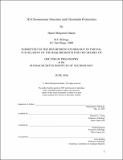| dc.contributor.advisor | Richard A. Young and Rudolf Jaenisch. | en_US |
| dc.contributor.author | Dadon, Daniel Benjamin | en_US |
| dc.contributor.other | Massachusetts Institute of Technology. Department of Biology. | en_US |
| dc.date.accessioned | 2016-09-13T19:08:40Z | |
| dc.date.available | 2016-09-13T19:08:40Z | |
| dc.date.issued | 2016 | en_US |
| dc.identifier.uri | http://hdl.handle.net/1721.1/104174 | |
| dc.description | Thesis: Ph. D., Massachusetts Institute of Technology, Department of Biology, 2016. | en_US |
| dc.description | Cataloged from PDF version of thesis. "May 2016." | en_US |
| dc.description | Includes bibliographical references. | en_US |
| dc.description.abstract | The selective interpretation of the genome through transcription enables the production of every cell type's distinct gene expression program from a common genome. Transcription takes place within, and is controlled by, highly organized three-dimensional (3D) chromosome structures. The first part of the work presented here describes the generation of 3D chromosome regulatory landscape maps of human naive and primed embryonic stem cells. To create these 3D chromosome regulatory landscape maps, genome-wide enhancer and insulator locations were mapped and then placed into a 3D interaction framework formed by cohesin-mediated 3D chromosome structures. Enhancer (H3K27ac) and insulator (CTCF) locations were mapped using ChIP-sequencing, whereas 3D chromosome structures were detected by cohesin-ChIA-PET. 3D chromosome structures connecting insulators (CTCF-CTCF loops) were shown to form topologically associating domains (TADs) and insulated neighborhoods, which were mostly preserved in the transition between naive and primed states. Insulated neighborhoods are critical for proper gene expression, and their disruption leads to the improper regulation of local gene expression. Changes in enhancer-promoter loops occurred within preserved insulated neighborhoods during cell state transition. The CTCF anchors of CTCF-CTCF loops are conserved across species and are frequently mutated in cancer cells. These 3D chromosome regulatory landscapes provide a foundation for the future investigation of the relationship between chromosome structure and gene control in human development and disease. The work presented in the second part focuses on developing an approach called "chromatin proteomic profiling" to identify protein factors associated with various active and repressed portions of the genome marked by specific histone modifications. The histone modifications assayed by chromatin proteomic profiling are associated with genomic regions where specific transcriptional activities occur, thus implicating the identified proteins in these activities. This chromatin proteomic profiling study revealed a catalog of known, implicated, and novel proteins associated with these functionally characterized genomic regions. | en_US |
| dc.description.statementofresponsibility | by Daniel Benjamin Dadon. | en_US |
| dc.format.extent | 226 pages | en_US |
| dc.language.iso | eng | en_US |
| dc.publisher | Massachusetts Institute of Technology | en_US |
| dc.rights | M.I.T. theses are protected by copyright. They may be viewed from this source for any purpose, but reproduction or distribution in any format is prohibited without written permission. See provided URL for inquiries about permission. | en_US |
| dc.rights.uri | http://dspace.mit.edu/handle/1721.1/7582 | en_US |
| dc.subject | Biology. | en_US |
| dc.title | 3D chromosome structure and chromatin proteomics | en_US |
| dc.type | Thesis | en_US |
| dc.description.degree | Ph. D. | en_US |
| dc.contributor.department | Massachusetts Institute of Technology. Department of Biology | |
| dc.identifier.oclc | 958133415 | en_US |
